by Lisa Cooke | Jan 6, 2017 | 01 What's New, Records & databases |
With an update to PERSI for genealogy, Pennsylvania birth and death records, and a tidbit or two from the United Kingdom and Scotland, you will start this year off right! It’s a new year and we are ringing in some great new and updated genealogical record collections.

PERSI for Genealogy
A monthly PERSI update has been added at Findmypast. With over 67,000 new articles and five new titles, the Periodical Source Index is the go-to source for those looking for stories of their ancestors. The new titles cover the American Historical Society, Chicago, Maryland, and British family histories & heraldry and will allow you to discover articles, photos, and other material you might not find using traditional search methods.
To fully appreciate PERSI as a genealogical tool, read our previous blog post “PERSI for Genealogy: the Periodical Source Index.” And you’ll find more related articles at the bottom of this article.
Pennsylvania – Birth and Death Records
This week, the Commonwealth of Pennsylvania released the 1911 births (105 years old) and 1966 death records (50 years old) to the public. This makes birth records publicly accessible from 1906 through 1911, and deaths 1906 through 1966. This collection index is free through the Pennsylvania Historical and Museum Commission portal.
Ancestry.com offers these records in digital form as well, but there is a subscription cost to use Ancestry. However, Pennsylvania residents can access these records free of charge through Ancestry.com Pennsylvania.
To access the index only, start with the Pennsylvania Historical and Museum Commission page on Vital Statistics for links to the indexes. You need to know the year of the event and the surname. If you do not know the year, you can search several years, one by one. These indexes are not digitized but are PDF files of the ones the State uses. If you locate a state file number for a certificate, you can order it from the State Archives.
However, if you are a Pennsylvania resident, you will be able to access the certificates digitally using the link to Ancestry.com Pennsylvania as mentioned above.
United Kingdom – Huntingdonshire – Marriages
New at Findmypast this week, the Huntingdonshire Marriages 1754-1837 collection contains over 1,000 names taken from 26 volumes of marriage records from the Huntingdonshire district of Cambridgeshire. These records will allow you to discover when and where your ancestor was married.
Scotland – Roxburghshire – Patient Registers
Also at Findmypast, explore the Roxburghshire, Kelso Dispensary Patient Registers 1777-1781. These registers contain over 1,700 names that list the date and outcome of patients’ treatment (such as cured, relieved of symptoms, or died). This may be particularly helpful for those unable to find a death date.
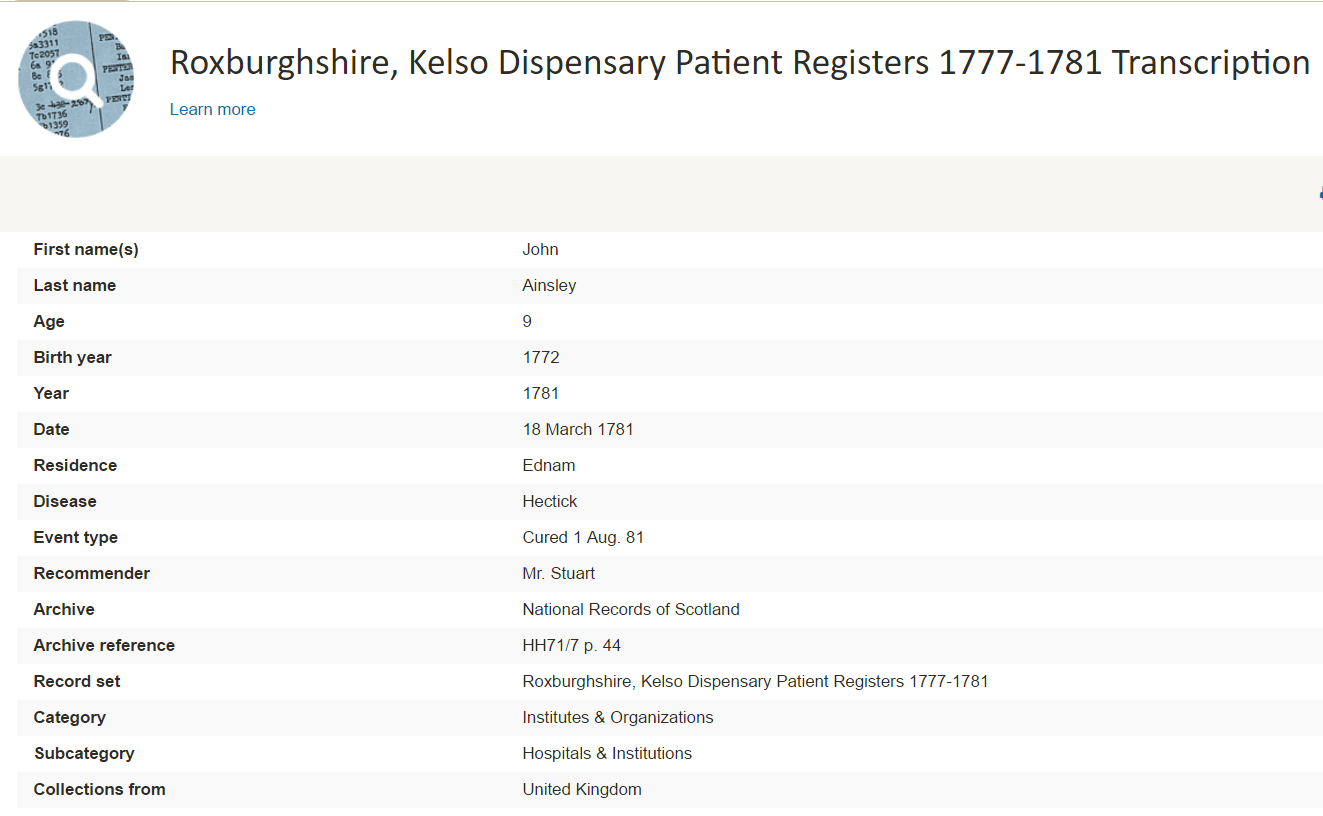
It should be noted that these are transcriptions only and you will not be able to see a digital image of the original.
More PERSI for Genealogy Articles
PERSI Digitized Collections Gaining Ground
New FindMyPast Hints Help Find Records
The Genealogy Gems Podcast Premium Episode 135: Compa rsion of Google Scholar & PERSI (Premium Member Subscription Needed)
rsion of Google Scholar & PERSI (Premium Member Subscription Needed)
by Lisa Cooke | Jun 3, 2017 | 01 What's New, British, Church, Findmypast, Legacy Tree Genealogists
English Parish records are a rich genealogical resource. England’s earliest useful census is from 1841, and civil records only go back to 1837. Let us help you trace your English family history before that time. English parish records might hold the key, and we’ve got all the information you need to get started searching them.
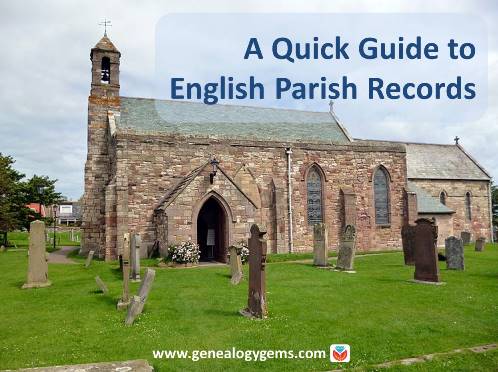
This post is the second in a series on finding your English ancestors by Kate Eakman of Legacy Tree Genealogists. Click here for the first installment on the difference between “Great Britain,” United Kingdom,” and “England;” census records and civil birth, marriage, and death records available through the General Register Office, or GRO.
Census and civil records are extremely useful and important for genealogical research in England. But the earliest useful census is from 1841, while the civil records only extend back to 1837. So what do researchers do to trace their English ancestors back to earlier times? How can you find your family if they emigrated in the 1700s or even earlier?
English Parish Records: The Back Story
Genealogists owe a debt of thanks to King Henry VIII’s chief advisor, Thomas Cromwell. After England’s split from the Roman Catholic Church, Cromwell issued an injunction in September of 1538 requiring every church in England to maintain a register of baptisms, marriages, and burials. The law was followed with varying degrees of consistency until Queen Elizabeth I, and the bishops of the Church of England reaffirmed the injunction in 1597. Wars, insects, water, and carelessness have led to the loss and destruction of many of these parish records, but there are still thousands of registers listing these important events available for our use today.
There are some Catholic Church records available for the years prior to 1538, but in general, the bulk of the ecclesiastical records begin with the Church of England or Anglican Church records starting in the mid- to late-1500s and extending into the late 1800s.
So what are you looking for, where do you find them, and what do those records provide? To explain that, we need to review how the church, whether Roman Catholic or Church of England, divided up the country.
- At the lowest level, we have parishes. The size of a parish can vary, and not every town or village had a parish church. Some parishes include a chapelry or two (small local churches or chapels which were under the jurisdiction of the parish priest). Within the records of the parish church is the most likely place for you to find information about your ancestors.
- Parishes were then grouped together under the jurisdiction of a bishop who was in charge of a diocese. There could be archdeaconries or rural deaneries within a diocese as well. Don’t overlook a record set for the archdeaconry or the rural deanery with the name of your ancestor’s town (Archdeaconry of Richmond or the Deanery of St. John).
- You will also see bishop’s transcripts which are just what it sounds like: copies of the parish records which were sent to the bishop of the diocese. These were generally made annually, and were required beginning in 1598, with most extending to the mid-1800s. Bishop’s transcripts were supposed to be exact copies of the parish records, but they may contain either less information (the local parish priest abbreviated the registers) or more information because the local minister had the luxury of time when recopying the registers and so added details not found in the original parish registers. Of course, there is always the possibility of error creeping in, as is true any time that someone is recopying text from one page to the next. It is wise to consult the bishop’s transcripts as well as the parish registers when they are both available so that you are certain that you have every detail available.

Finally, the parish church was not always the closest church to a family’s home. A baptism, marriage, or burial could have taken place in a neighboring parish. If you are unable to find the parish records where you expect to find them, use a map to search for neighboring parishes and try searching for your ancestors there.
Finding Your Ancestors in English Parish Records
It is not uncommon to find that several children from a family were baptized in one church and the others were baptized in a different church, so look around and keep in mind what is a reasonable walking distance for parents with a baby, a bride and groom, or to carry a dead man’s body for burial. Look for places less than three miles from the home of your ancestors.
The same folks who provide us with a free index to civil birth, marriage, and death records also have provided transcripts of ecclesiastical baptismal, marriage, and burial records at FreeReg. Here you can enter the name, a range of dates, the county, and select the type of records. Be sure to click on the “Name Soundex” box in case your ancestor’s name was spelled slightly differently than the modern version. Although these are transcripts with no links to the actual records, this site can help you to narrow down a broad range of choices to the one most likely to belong to your relative.
English Parish Records: Baptismal Entries
Baptismal entries generally include the date of the baptism, the place of the baptism (including the church name), and the names of the parents of the child. The mother’s maiden name is almost never included unless the child was illegitimate. It is also important to remember that baptisms could occur anywhere from the day of birth up to three or more years after the child’s birth. Unless the record specifies the date of birth, assume that it occurred up to three years earlier when continuing your research.
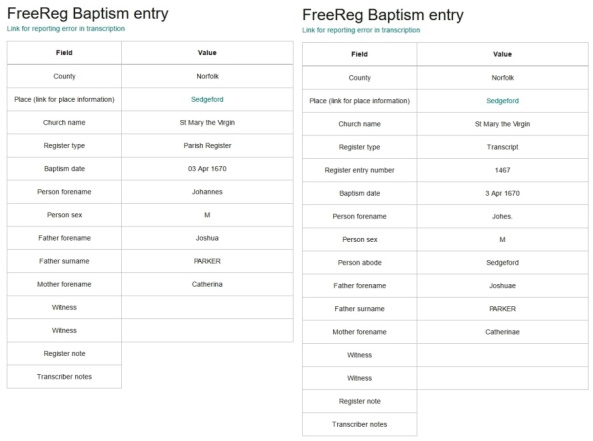 Transcripts of parish register on the left and bishop’s transcript on the right for the same person, John Parker. Due to the use of Latin and the different sentence construction, the names appear to be slightly different, but both are translated as John Parker, son of Joshua and Catherine Parker. Images courtesy https://freereg.org.uk.
Transcripts of parish register on the left and bishop’s transcript on the right for the same person, John Parker. Due to the use of Latin and the different sentence construction, the names appear to be slightly different, but both are translated as John Parker, son of Joshua and Catherine Parker. Images courtesy https://freereg.org.uk.
English Parish Records: Marriages
Marriage records will include the date and location of the marriage, which was usually the parish church of the bride. Both the bride and the groom will be named, but it is rare to find any additional information such as the occupation of the groom or the names of their parents.
The examples of a parish register and the archdeacon’s transcripts provide variant spellings of the groom’s surname: Wasy and Acye or Wacye. The bride’s given and surnames have different spellings as well: Amie and Amye and Cots or Cottes. This is why we encourage researchers to use the “Name Soundex” box, particularly since these records are for the man known as Thomas Wise today.
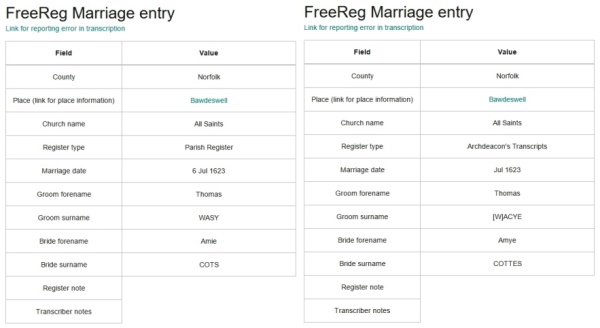
Note the different spellings of the names although the archdeacon’s transcript was supposedly a copy of the parish register. Images courtesy https://freereg.org.uk.
English Parish Records: Burials
Burial records, which are not the same as death records, provide the name of the deceased, the date and place of his or her burial, and the names of the parents. If the deceased was married, the name of the husband or wife is also included. Most burials occurred between one and three days of death, but unless the record specifies a specific date of death, it is best not to assume a particular day.
The burial record below is an excellent example of additional information which can be included on a bishop’s transcript. The parish records no longer exist for burials from the cathedral church of Durham, but the bishop’s transcript provides very useful additional details. From this record, we learned that William James, who was buried on 3 April 1634, was baptized on 24 June 1632. His father, also named William James, was buried 21 January 1659/60.
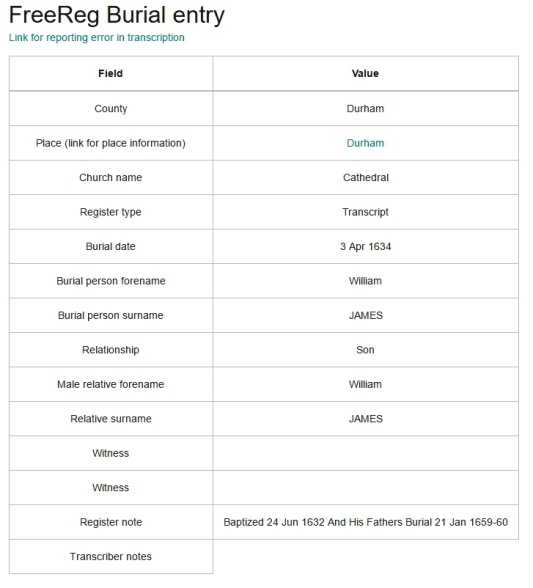
The split date for the burial of William James, Sr. (21 January 1659/60) indicates the date differences of the Julian and Gregorian calendars. This type of annotation can be seen during the first three months of each year in English records until 1751 when England officially accepted the Gregorian calendar. Image courtesy https://freereg.org.uk. Click here to learn more about Julian and Gregorian calendars.
Online Parish Clerks Websites
There are also a number of Online Parish Clerks (OPC) websites which allow you to search for transcriptions. Lancashire’s OPC site is one of the most complete sites and is easy to use. If you are fortunate enough to have ancestors from Lancashire, definitely use this site. For other OPC sites, go to UKBMD.org for links to about 20 other projects.
Obtaining Copies of English Parish Records
Once the transcripts of your English ancestor’s baptisms, marriages, and burials have been located, you can turn to several sources to locate the actual copies of the records. There are some digital copies available on FamilySearch.org. (Note that the agreement that the Family History Library has with a number of the repositories requires that you access the records from a local LDS Family History Center and not from your home.) You can also find copies of the documents on the for-fee site FindMyPast.com (and click here for English Catholic parish records at Findmypast.com).
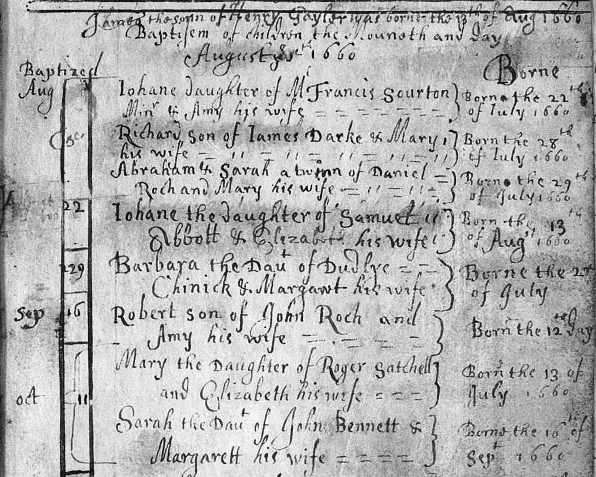
Devon Parish Registers showing 1660 baptisms from http://findmypast.com.
Parish registers and bishop’s transcripts are very useful for tracing English ancestors back to the mid-1500s. The registers include baptismal, marriage, and burial records and although they often contain only the bare minimum of information, that can be used to research and extend your family tree. Because everyone in the parish was included–not just the wealthy and powerful–these records can allow us to trace our English ancestors for many generations.
 Get more help finding your ancestors
Get more help finding your ancestors
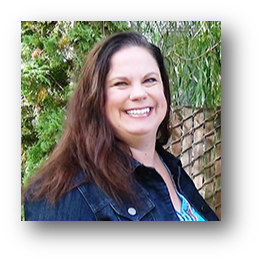 Legacy Tree guest blogger Kate Eakman grew up hearing Civil War stories at her father’s knee and fell in love with history and genealogy at an early age. With a master’s degree in history and over 20 years experience as a genealogist, Kate has worked her magic on hundreds of family trees and narratives. Let Legacy Tree Genealogists like Kate apply their expertise to your family history brick walls! Click here to request a free consult–and take this exclusive Genealogy Gems coupon code with you: $100 off a 20-hour+ research project with code GGP100. (Offer subject to change without notice.)
Legacy Tree guest blogger Kate Eakman grew up hearing Civil War stories at her father’s knee and fell in love with history and genealogy at an early age. With a master’s degree in history and over 20 years experience as a genealogist, Kate has worked her magic on hundreds of family trees and narratives. Let Legacy Tree Genealogists like Kate apply their expertise to your family history brick walls! Click here to request a free consult–and take this exclusive Genealogy Gems coupon code with you: $100 off a 20-hour+ research project with code GGP100. (Offer subject to change without notice.)
by Margaret Linford | Jan 31, 2018 | 01 What's New, Court Records, Research Skills |
Using wills and probate records for genealogy can lead to unexpected “inheritances” of your own: clues about relatives’ identities, wealth, personal belongings, and family relationships. Wills can reveal great family stories, too: researcher Margaret Linford entertains her mother with them during trips to the courthouse. Here’s how wills can help your family history—and Margaret’s tips for finding and using them.
Using Wills and Probate Records in Genealogy Research
“Where there’s a will, there’s a way” to find out more about your family’s history.
Wills are legal records created to direct the settlement of a person’s property and other final affairs after his or her death. Probate (or estate) records are created after an individual’s death as part of the legal distribution of the estate and payment of debts. You’ll often find wills as one of many kinds of the documents included in probate records.
Wills and other probate records are valuable research tools, but are frequently neglected as sources of genealogical information. People often focus strictly on birth, marriage, and death records when searching out their family histories. If you rely solely on those records, your research will encounter many brick walls in the early 1800’s.
Probate records and land records were often the only official documents left behind to tell the stories of ancestors who lived prior to the legal requirement for the registry of births and deaths.
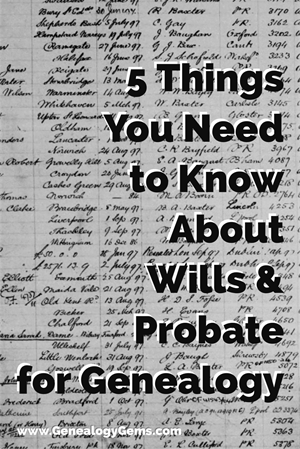
Wills of slaveholders can also be valuable tools in conducting African-American genealogical research. Before the Civil War, enslaved people were listed in wills because they were valuable property of slaveholders.
For instance, in the 1863 Smyth County property tax records, it is noted that Abijah Thomas owned 56 slaves, which were valued at $53,800. Some were given their freedom within wills, while others were transferred to other members of the family or sold. For instance, one of the first wills recorded in Smyth County is that of Hugh Cole.
Within his will, he says the following: “I bequeath to my beloved wife Martha Cole a negro girl named Amanda which she is to hold during her natural life.” The mention of an enslaved person in a will—along with any personal description of him or her—may be the only surviving document to mention that person by name.
Within another Smyth County will, recorded on February 20, 1835, a woman named Elizabeth Blessing left the following directive: “I will and desire that my negro woman Betty be free at my decease, and must see to her own support during her life, as I shall not make any provision for her out of any part of my estate.”
Information Found in Wills Varies
You can find just about anything in a will!
One organ, one compass, chain and plotting instruments, two chests, one hat rack, one music rack, one old United States map. These are some of the items found in the appraisement bill of the personal property belonging to the estate of Abijah Thomas, who lived in the well-known Octagon House in Marion, Virginia.
Here is a photo of that home, now in a dilapidated state, from a Wikipedia file image (click image for attribution.)

Also included in his personal property is a church bell. The story behind the bell is intriguing and illustrates the significance of the probate process.
Abijah Thomas utilized the bell at his foundry works in Marion, Virginia, to indicate shift changes. For decades, the oral history surrounding the bell indicated that he had donated it to the Wytheville Presbyterian Church before he died. The court documents reveal a different story.

Court document regarding the church bell
Since Abijah died intestate, the court appointed three men to appraise his personal property. During this process, the bell was valued at $75. It was sold on September 1, 1877, to the Presbyterian Church in the town of Wytheville, Virginia, as shown in the above list of items sold from his estate.
This document dispels the family myth surrounding the church bell. This is just one of many examples of the types of stories you find in probate records in courthouses all across the United States.
Genealogical Information May be Found in a Will or Probate Records
Wills and probate records can pass along unexpected genealogical wealth to you. You may find the following information in them: date of death (or approximate date of death), name of spouse, children, parents, siblings and their place of residence, adoption or guardianship of minor children, ancestor’s previous residence, occupation, land ownership, and household items.
Probate records also contain such interesting stories that they can even be read for entertainment!
Whenever I go on a research trip, I usually drag some poor, unsuspecting soul along with me. That person is usually my Mom. While she enjoys the scenery on our drive to different courthouses, she rarely enjoys the time spent at the courthouse.
Some of the research I do requires me to stay at the courthouse for several hours. That has posed a problem in the past since I haven’t known how to keep Mom occupied. But I have found the perfect solution. When we arrive at the courthouse, I find an old will book and let her start reading.
My mom enjoys reading the stories in these old—and sometimes tattered—books. One of her favorite stories came from a will in Henry County, Virginia. It is the will of Addie T. Thornton and reads as follows:
“I also give to my nephew Thomas T. Earles, fifty ($50) in cash to be deposited in some safe Banking Institution, on interest until he arrives at the age of twenty-one (21) years old and then the principal to be invested in a watch and I request that a monogram with both his and my name, one on inside and the other on outside of watch.”
Obviously, Addie Thornton cared deeply for her nephew, Thomas, and wanted to make sure he remembered her for the rest of his life.
Here’s part of Addie’s will, followed by a closeup image of the lines about the watch:
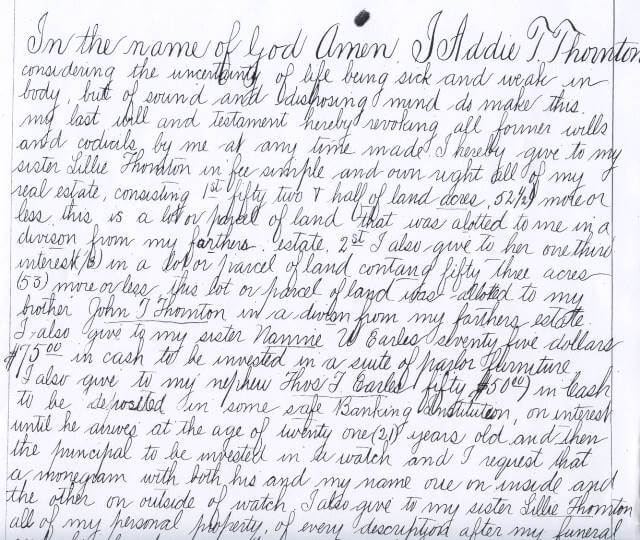

Stories like these are so much more meaningful than just a date of birth, marriage or death. Wills can help us know who these people were, how they lived and what was important to them during their sojourn here on earth. We can learn of their struggles and their successes. We can tell what their lives were like by reading through the lists of household items included in the inventories that are recorded.
And with stories like Addie’s bequest of the watch, we can also learn about ancestors’ personalities and how they expressed (or occasionally withheld) love for others through the final disposition of their belongings.
How a Will is Created
Before beginning probate record research, it is important to be familiar with the probate process and legal terminology associated with these records. It is estimated that, prior to 1900, about half of the population either left a will or was mentioned in one. Those who died having left a will are said to have died “testate.” Those who died without leaving a valid will died “intestate.”
A typical, legally-recognized will contains certain critical elements. It should be in written form and it must have signatures of the person leaving the will (“testator”) and witnesses, who attest to the validity of the document. A codicil is a document created by the testator to amend the will.
Once the testator dies, the will is presented to the judicial authority by a family member or executor/executrix (person appointed by the testator to see that his/her wishes are carried out), accompanied by a written application or petition for probate.
These petitions include names and addresses of the closest living relatives. The court then admits the will to probate and sets a hearing, providing an opportunity for interested parties to contest the will. The will is then recorded and the executor is given the authority to settle the estate. During this process, an inventory of the estate is made.
Some wills contain detailed information, regarding the testator’s final wishes. At times, these requests will shed light on relationships that might not otherwise be discovered. This was the case for a will on file at my local courthouse. Due to the nature of the requests made by the testator, I have changed the last name of the family to Smith. This wife was, obviously, upset with her husband and the circumstances of their marriage, providing clear details of her grievances for future generations.
“Since my husband has never made me a part of his family and has completely cut me out of ever living in Chihowie, Virginia [the husband’s hometown], or never provided me with a home or paid any of my bills and has broken all marriage contracts that we agreed to—I hereby decree that I be buried in Round Hill Cemetery at Marion, Virginia, where I own a lot—that my body or anything I own or possess will never be taken into Chilhowie or the Smith household.
My husband has never taken me into his own home, and furthermore stated, backed up by his nephew and his wife, whom he turned everything over to shortly after our marriage—that I would never own or live on a foot of the Smith ground, even though I have tried to build or buy or remodel a home in Chilhowie, Virginia, at my own expense.
“I give all books and material things pertaining to books to the Smyth County Library, Marion, Virginia, as I am sure that my family would not want anything to fall into the hands of anyone who has mistreated me.
“My husband has kept our marriage strictly on a time clock basis since his nephew and his wife moved back to Smyth County, and under their influence he comes at 6:30 or 7:00 p.m. (whichever is convenient to them) or later, and leaves promptly in the morning by 8:00 or 8:30 a.m., never calling during the day or show[ing] any sign of caring. He changed completely after they returned to Chilhowie to break up the marriage. Therefore, if I am still his wife, or otherwise, see that my wishes are carried out and that my remains and possessions remain in Marion.”
Where to Find Wills and Probate Records
The best place to search for a will is at the courthouse where your ancestor lived, if you can reasonably go there yourself.
Since the probate process is a function of state governments, the laws governing the maintenance of these records and their location will vary by state and should be researched before making a trip to the courthouse.
For example, in Virginia, probate records are maintained within the Circuit Courts and independent cities. In Massachusetts, probate records are found in county Probate Courts.
A useful resource for figuring out how U.S. probate records are organized state-by-state is free on the Ancestry.com wiki: Red Book: American State, County and Town Sources. Scroll down to click on the name of the state in question. Then go to the right side and click on the probate records link for that state to read about these records.
Once you have determined where the wills for your state/county are housed, the next step in the research process is to locate the Index for Wills. Even–perhaps especially–if you are unsure of the date of death for one of your ancestors, you may want to look through the index of wills (an example is shown here). Even when no specific death record exists, you may be surprised to find probate records that reveal the date of death, a list of heirs and more.
There will, most likely, be several index books, organized by year spans. These books serve as a compass, pointing you to any available probate records that may include your ancestors. The index is divided by devisor (the person making the will) and devisee (any person who is named in the will, as the recipient of property).
The research process will be incomplete if you do not conduct a search for your ancestors among the list of devisees. Even if you fail to find their names among the devisors, they could have inherited property from someone else.
Probate records include more than just the will of an individual. You may find letters of administration, lists of heirs, inventories, bills of appraisement, guardianships and other documents related to the settlement of an estate. In some counties, all these documents are found in the same collection. Other counties maintain these records in separate collections. It is important to understand the manner in which probate records are organized for your particular county.
The probate research process should not be rushed. Valuable records may be overlooked when time dictates the quality of your research. For this reason, it is important that you set aside ample time to comb through the probate records. If you find yourself confused about abbreviations or the location of records within the courthouse, there is usually someone in the records vault who would be happy to assist you. Never be afraid (or embarrassed) to ask for help.
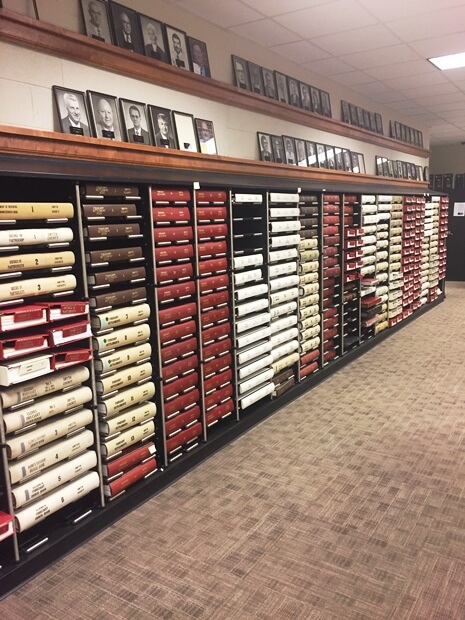
Fortunately for many of us who can’t easily get to every ancestor’s courthouse, there are some wills available online on genealogy websites, including two of the genealogy giants, FamilySearch and Ancestry.com.
For example:
- Subscription website Ancestry.com has made it a priority to curate an enormous collection of wills and probate records from all 50 states. At last count, this collection has more than 170 million records—and they keep adding to it.
- The free FamilySearch.org hosts millions of probate records from the U.S. and around the world (click here to browse their probate and court record collections). Many of these collections are marked “browse-only,” which means they are not yet searchable by name online. You just have to page through them. Click here for instructions on reading browse-only records on the site (it’s not that difficult—and did I mention they’re free?).
Additionally, libraries or genealogical societies in your ancestor’s hometown or county may have books with abstracts from local wills or other resources related to local probate record research.
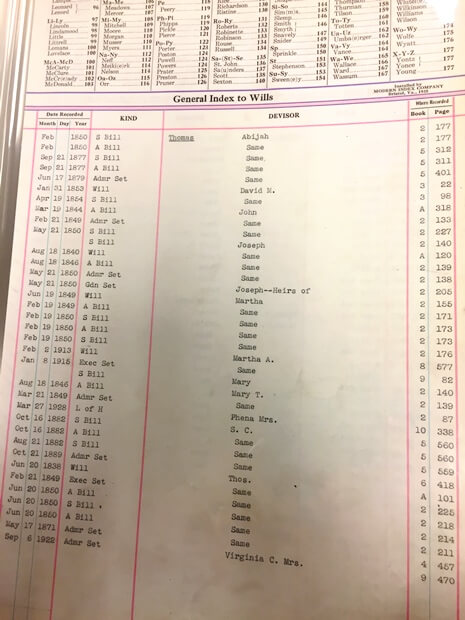
General Index to Wills
Well Worth the Effort
Finding the will of one of your ancestors is an amazing experience. Walking into the vault of a courthouse sometimes feels like walking into a time machine. As you read through the pages that tell of people who lived so long ago, you feel like for even just a small moment that you have gone back in time. You are sitting with them and hearing their stories whispered through the aging and brittle pages that have been left behind. They are all there just waiting to tell their stories. So take the opportunity to go to the courthouse and “meet” your ancestors through the one of the last—and perhaps one of the most revealing—documents they may ever have written: their wills.
Researching Wills and Probate Records: Your Next Steps
Take your genealogy research to the next level by planning a trip to a courthouse to retrieve records like wills and probate records. These articles and podcast episodes will help you get ready:

Disclosure: This article contains affiliate links and Genealogy Gems will be compensated if you make a purchase after clicking on these links (at no additional cost to you). Thank you for supporting Genealogy Gems!

Margaret Linford is a professional genealogist who specializes in the Mid-South Region of United States research and has logged over 20,000 research hours. Born and raised in Virginia, she has enjoyed traveling the world, and now lives in her childhood hometown with her husband and children. She enjoys teaching her children about heritage, taking them along on research trips and serving as President of the Smyth County Genealogical Society.
by Lisa Cooke | Mar 11, 2017 | 01 What's New, RootsMagic |
A GEDCOM file is a universal type of file that genealogists use to move data from one genealogy software program to another. Using these helpful tips below, you can open genealogy files your family members send to you, or share your data with others.
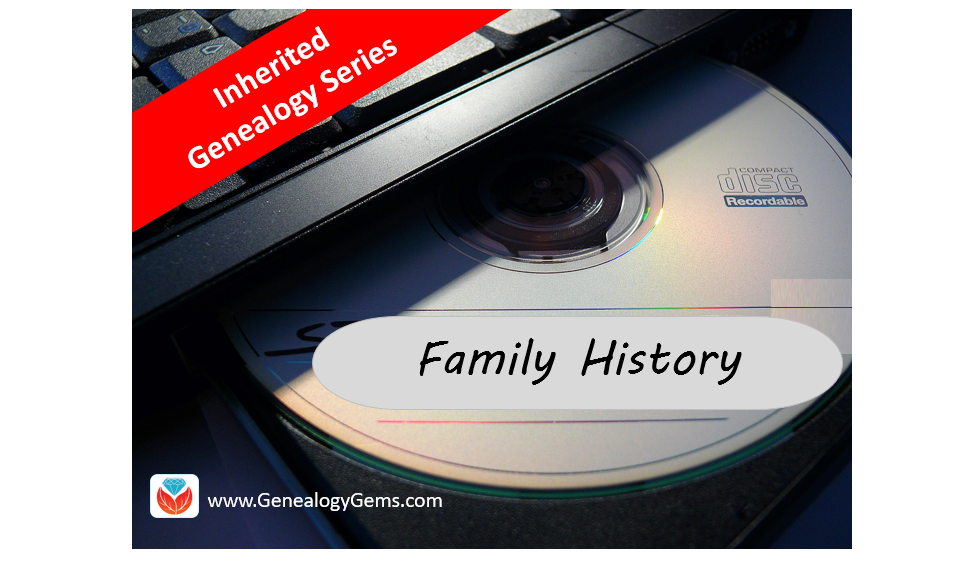
When and Why You Would Need to Open a GEDCOM File
A Genealogy Gems reader recently wrote:
I recently signed up for [the Genealogy Gems] newsletter. I received a CD from a relative with family history information that was set up through Family Tree Maker. I am currently not subscribed to any of the genealogy sites. My question is, how can I retrieve this information [from the CD.] Can you help?
The answer to the question is: Use another program to open the GEDCOM file from the CD. Let me show you how easy it is to open and create GEDCOM files.
GEDCOM Basics
GEDCOM is an acronym standing for Genealogical Data Communication. It is a universal genealogy file that allows you to exchange genealogical data between different genealogy software programs.
Because it is “universal” in nature, a GEDCOM file can be read by many different types of genealogy software. That means, if you are using RootsMagic, you can still share all the data you have collected with your cousin who uses Family Tree Maker, and she will not have to type in all the names, dates, and places manually.
Occasionally, not all the information included in a GEDCOM file will transfer perfectly. There are differences in how that information is interpreted and some things, like notes and sources, may be affected. However, for the most part, much of it will transfer correctly.
How to Open a GEDCOM File
Our reader needs to open a GEDCOM file contained on the CD he was sent. To do this, he must have a program on his computer that will read a GEDCOM file. There is an option I would like to share with you.
RootsMagic is a downloadable software for both Mac and PC users. (And, it is the one we here at The Genealogy Gems Podcast use! That’s why we accepted them as a sponsor of the podcast.)
Once you have downloaded RootsMagic to your computer, open it. At the top left corner, click on File and from the pull-down menu, choose Import.
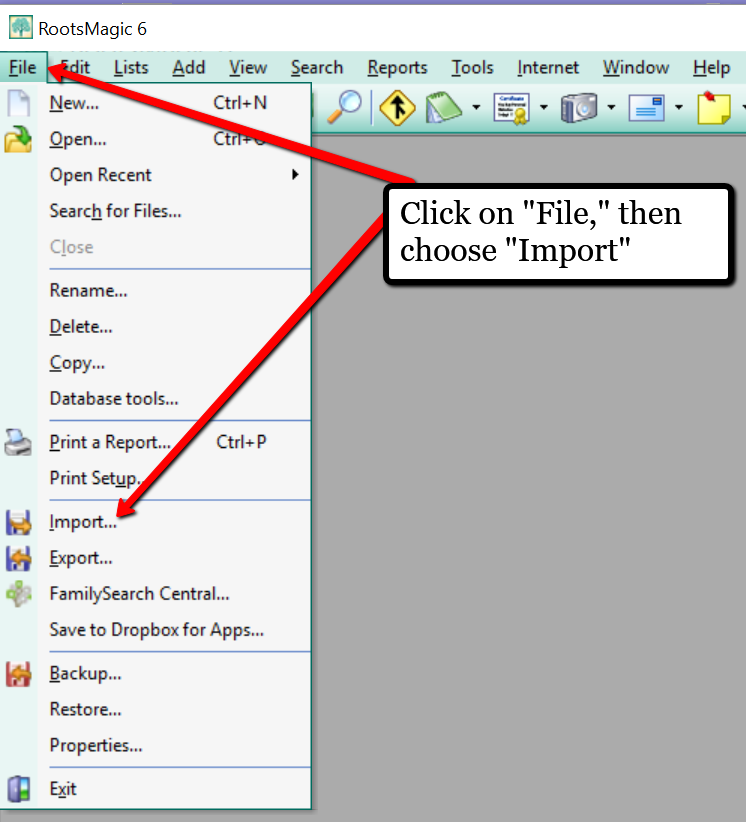
Now, a new pop-up window will open and ask from what source you would like to import from. You will notice several options, but for our reader’s question, he will choose the GEDCOM option.
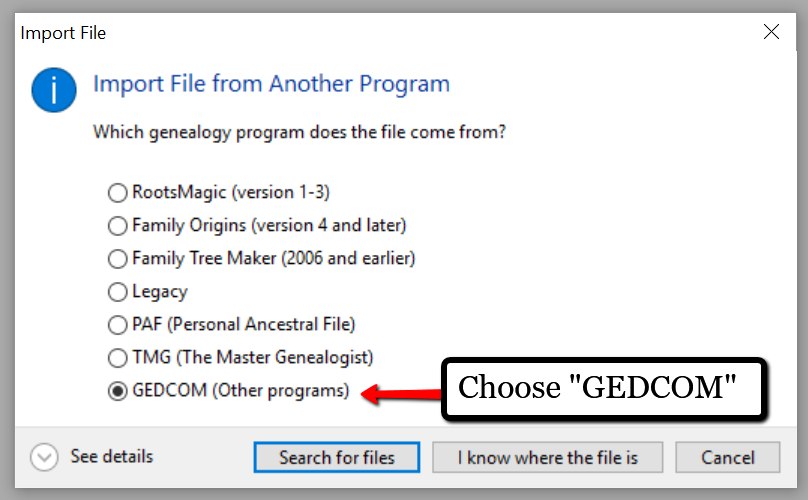
Then, choose I know where the file is, and the file explorer window will appear. In this case, our reader would click on the CD that he has loaded into his computer’s disk drive, and follow the prompts to open the GEDCOM file. All that information his relative sent him will be slurped into RootsMagic and he can easily look through the pedigree of his family.
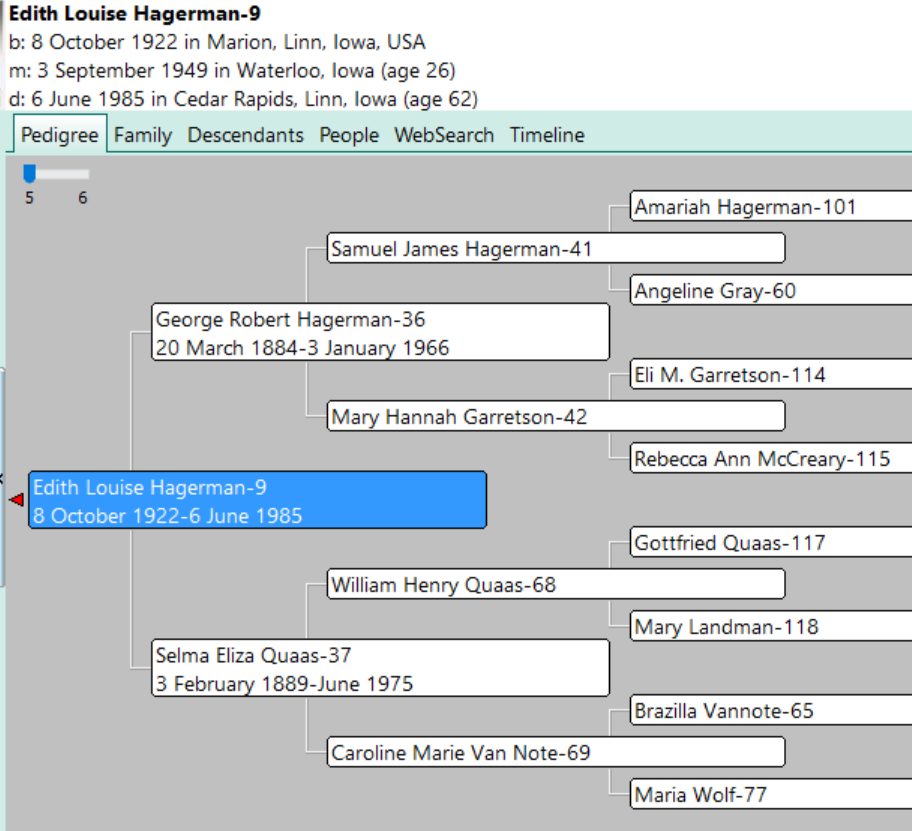
Creating a GEDCOM to Share with Others
RootsMagic also allows you to create a GEDCOM file. This is what you would send to your relatives when they would like to have a copy of the family tree.
To do this, open RootsMagic. Click on File, as we did before, and this time choose Export from the pull-down options.
The export box will pop-up. You can choose what you wish to have included in this export. I typically choose Everyone, but you can do yours by family names by clicking on the down arrow next to Everyone and choosing Select from list.

Once you have clicked OK, the GEDCOM file is ready to be saved to your computer. Save the file on your desktop or somewhere you will be able to locate it again. Remember to name the file and pay attention to where you are saving it!
Creating a GEDCOM from Ancestry.com
If you have stored your genealogy data at Ancestry.com, you may be interested to know that you can create a GEDCOM file for your family tree there as well. It’s just a matter of signing into your Ancestry account, locating the Tree Settings, and then clicking Export. I found a nice article outlining the steps on how to do that here.
Protecting Your GEDCOM Files
Creating a GEDCOM is also a great way to save or backup your hours and hours of family history research. One of the saddest tales of genealogists everywhere is losing their computer or printed family files with all that work!
GEDCOM files can be saved to a hard drive, saved to an external unit, emailed, put on a thumb drive, or uploaded to the Cloud. You can also invest in a company like Backblaze, the official backup of The Genealogy Gems Podcast, that will automatically backup all your files. (Read more about Backblaze, here.) All of these methods protect you and your genealogy.
More on Protecting Your Genealogical Data
Learn more about Backblaze, The Genealogy Gems Podcast’s first choice when it comes to backing up precious genealogy research and personal files. Read the article’s below and determine if Backblaze is the answer you’ve been looking for.
How to Download Backblaze in 4 Easy Steps
Backing Up Your Genealogy with Backblaze – Q & A


 rsion of Google Scholar & PERSI (Premium Member Subscription Needed)
rsion of Google Scholar & PERSI (Premium Member Subscription Needed)


 Transcripts of parish register on the left and bishop’s transcript on the right for the same person, John Parker. Due to the use of Latin and the different sentence construction, the names appear to be slightly different, but both are translated as John Parker, son of Joshua and Catherine Parker. Images courtesy https://freereg.org.uk.
Transcripts of parish register on the left and bishop’s transcript on the right for the same person, John Parker. Due to the use of Latin and the different sentence construction, the names appear to be slightly different, but both are translated as John Parker, son of Joshua and Catherine Parker. Images courtesy https://freereg.org.uk.



 Legacy Tree guest blogger Kate Eakman grew up hearing Civil War stories at her father’s knee and fell in love with history and genealogy at an early age. With a master’s degree in history and over 20 years experience as a genealogist, Kate has worked her magic on hundreds of family trees and narratives. Let Legacy Tree Genealogists like Kate apply their expertise to your family history brick walls!
Legacy Tree guest blogger Kate Eakman grew up hearing Civil War stories at her father’s knee and fell in love with history and genealogy at an early age. With a master’s degree in history and over 20 years experience as a genealogist, Kate has worked her magic on hundreds of family trees and narratives. Let Legacy Tree Genealogists like Kate apply their expertise to your family history brick walls! 












